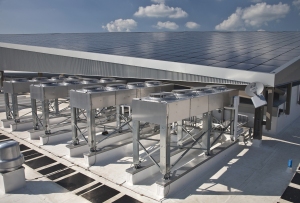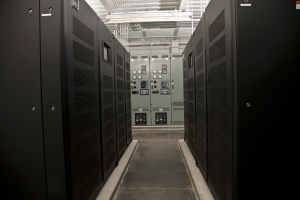What is the cheapest PC you can buy that can sport 8GB of RAM? You would think this was a simple question, and within a few minutes of online shopping you could figure it out. Alas, this has turned into Yet Another Project, and I am nowhere near the answer.
Why would anyone want such a machine? Any 32-bit version of Windows can’t use much beyond 3 GB of memory. If you are going to effectively use 8 gigs of memory, you need a 64-bit operating system. I actually have one that I am using right now – my Mac OS. But getting a Mac with all that memory means getting their pricier Mac Pro desktop. And while you can save some money by getting a used Mac Pro, by the time you bulk it up with enough RAM and disk, it isn’t much of a bargain anymore.
My reason for all this RAM is to host a collection of virtual machines for testing purposes. VMs consume a lot of RAM, and there are situations where I want to be able to run more than one VM at a time for testing networking products. I have been using the desktop VMware Workstation along with Fusion on my Mac, and have quite a collection of VMs now that I use in my tests. But my Windows PCs only have 2 GB of RAM, so I can’t really run more than one VM at a time. I needed something more powerful. A few months I had a client that sent me a DVD with seven different VMs on it to use for a series of tests.
So I thought to contact a system builder friend of mine and I ask him to spec out for me what I called a “white box ESX PC” – ESX is VMware’s virtual server operating system, and it is designed for this purpose, to run a lot of VMs on a single physical piece of hardware. And while ESX technically isn’t 64-bit, it can run very effectively with lots of memory.
But getting the right configuration was tricky, because it is also not designed to run its VMs on an ordinary hard disk that you would find in your average desktop. There are some discussion forums on this topic, but we were in uncharted territory.
To see what I was getting myself into, HP loaned me one of their Proliant servers that comes with ESX pre-installed. (Most of the major PC server makers have a selection of pre-installed machines with either ESX or Citrix’ Xenserver, but these are not low-end machines.) It took me weeks of effort to get the right licensed software from VMware to operate it and put the VMs on the box. I realized that ESX wasn’t going to work for me –there was just too much overhead. And while VMware gives away a freebie version called ESXi, I was too fed up at this point to try that route. If you want to learn more, check out this article here.
So then I went online and starting poking around to see if I could order a desktop PC with 8 GB of RAM and be satisfied running the 64-bit Vista OS. I first went to Dell, mainly because I buy a lot of Dells and can find my way around their Web site. Back in the day when megabytes were a lot of RAM, Dell was one of the first vendors to sell PCs with 4 MB installed. But despite this history and familiarity, it wasn’t easy to search their Web site for an 8 gig PC. Lenovo has one line, the ThinkCentre M58, which sells for about $1200. HP has none that I could find on their Web site, which is odd because when I went to Newegg’s Web site I could find more than 20 configurations, some of which were pretty capable HP machines, all for around $1000.
The other issue with running a lot of VMs besides RAM is that you want the right CPU inside your PC, one that supports the virtualization extensions called Intel-VT or AMD-V. Neither company makes it very clear which of its Dual Core Duo this or that processor actually supports these extensions. Check out this discussion here. And Ed Bott does further research and actually reports on which Intel CPUs offer the extensions in his post here.
What I do know is the aging Dell desktop that I bought three years ago doesn’t have this support. Sigh. Here is a link to a discussion forum on Anandtech that goes into more details.
So meanwhile I haven’t bought anything yet. If you have any advice, you know where to find me.
 I had an opportunity to visit Emerson’s new data center located here on their St. Louis campus. The most interesting feature isn’t inside the building, but a 100 kV (DC) solar array that is attached to the roof of the building and provides about 15% of the power requirements for the equipment inside. The array is canted a bit for the optimum angle, because Emerson wanted the building placed in a particular spot on its campus that didn’t match the best orientation for the array. Currently, it is the largest collection of solar panels in Missouri.
I had an opportunity to visit Emerson’s new data center located here on their St. Louis campus. The most interesting feature isn’t inside the building, but a 100 kV (DC) solar array that is attached to the roof of the building and provides about 15% of the power requirements for the equipment inside. The array is canted a bit for the optimum angle, because Emerson wanted the building placed in a particular spot on its campus that didn’t match the best orientation for the array. Currently, it is the largest collection of solar panels in Missouri. The data center has a mirror (without the array) in Iowa that is used for disaster recovery and R&D purposes. It is also the first commercial deployment of Liebert’s NXL power conditioning system (pictured at right). Eventually, the data center will house 400 servers, and another innovative feature is that all rack-to-rack connections will be handled by fiber optics, rather than copper.
The data center has a mirror (without the array) in Iowa that is used for disaster recovery and R&D purposes. It is also the first commercial deployment of Liebert’s NXL power conditioning system (pictured at right). Eventually, the data center will house 400 servers, and another innovative feature is that all rack-to-rack connections will be handled by fiber optics, rather than copper.